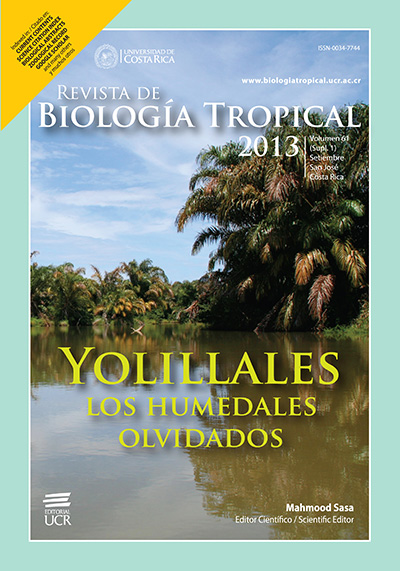Abstract
In the Tortuguero region, northeastern Costa Rica, tropical forests are home to over 300 species of birds. Within this ecosystem, wetlands dominated by the raffia palm Raphia taedigera and the royal palm Manicaria saccifera extend in large monospecific swamps locally known as yolillales. These wetlands are characterized by low plant diversity, simple structure, waterlogged soils, and extended hydroperiod. There is hardly any information on the bird communities that inhabit or uses yolillales. We describe this ornitofauna, comparing the species that inhabit the palm-swams and in the adjacent forest in terms of species richness and diversity. During October-November 2008, we used transects and hearing stations in both habitats in four locations in the region. We located a total of 11 bird species in the palm-swamps and 31 in the adjacent forests. Our observations suggest that palm-swamps have lower species richness than adjacent forests and that these environments also differ in species composition. Despite their low diversity, yolillales are employed by species with different degrees of vulnerability, so that they may be important for bird conservation in the region. Sampling in yolillales is very hard, so our data should be considered preliminary. Further efforts in these environments are needed to improve our knowledge on the bird community that uses them.
References
Bibby, C.J., N.D. Burgess, D.A. Hill & S.H. Mustoe. 2000. Bird Census Techniques. Academic, Londres, Inglaterra.
Blake, J.G. & B.A. Loiselle. 1991. Variation in resource abundance affects capture rates of birds in three lowland habitats in Costa Rica. Auk 108: 114-127.
Blake, J.G. & B.A. Loiselle. 1992. Fruits in the diets of Neotropical migrant birds in Costa Rica. Biotropica 24: 200-210.
Blake, J.G. & B.A. Loiselle. 2001. Bird assemblages in second-growth and old-growth forest, Costa Rica: perspectives from mist nets and point counts. Auk 118: 304-326.
Bonilla-Murillo, F., D. Beneyto & M. Sasa. 2012. Anfibios y reptiles de los pantanos dominados por la palma de yolillo Raphia taedigera (Arecaceae) en el noreste de Costa Rica. Rev. Biol. Trop. 61 (Supl. 1): 143-161.
Brightsmith, D. & A. Bravo. 2006. Ecology and management of nesting blue-and-yellow macaws (Ara ararauna) in Mauritia palm swamps. Biod. Cons. 15: 4271-4287.
Campbell, D.G., D.C. Daly, G.T. Prance & U.N. Maciel. 1986. Quantitative ecological inventory of Terra Firme and Varzea tropical forest on the Rio Xingu, Brasilian Amazon. Brittonia 38: 369-393.
Cooper, J. & J. Loomis. 1993. Testing whether waterfowl hunting benefits increase with greater water deliveries to wetlands. Env. Res. Econ. 3: 545-56.
Garrigues, R. & R. Dean. 2007. The Birds of Costa Rica: A Field Guide. Cornell University, Nueva York, EE.UU.
Gómez, L.D. 1986. Vegetación y clima de Costa Rica: apuntes para una biogeografía costarricense. v. 1. Vegetación. EUNED, San José, Costa Rica.
González, J.A. 2003. Harvesting, local trade, and conservation of parrots in the Northeastern Peruvian Amazon. Biol. Conserv. 114: 437-446.
Gotelli, N.J. & G.L. Entsminger. 2001. EcoSim: Null models software for ecology. Version 7.0. Acquired Intelligence Inc. & Kesey-Bear (Consultado: 30 julio 2012, www.homepages.together.net/~gentsmin/ecosim.htm).
Graham, D. 1996. Diet and foraging behaviors of two abundant understory frugivorous birds, Pipra mentalis (Pipridae) and Mionectes oleaginous (Tyrannidae in a humid lowland Neotropical forest. Ph.D. Thesis, University of Miami, Miami, Florida.
Hammer, Ø., D.A.T. Harper & P.D. Ryan. 2001. PAST: Paleontological statistics software package for education and data analysis. Palaeontologia Electronica 4(1): 9pp. (también disponible en línea: www.palaeo-electronica.org/2001_1/past/issue1_01.htm).
Hidalgo-Calderón, C. 1993. Avifauna del Refugio Nacional Silvestre Caño Negro. Congreso de Ornitología de Costa Rica, San José, Costa Rica.
Holdridge, L.R. 1967. Life zone ecology. Tropical Science Center, San José, Costa Rica.
Magurran, A.E. 1989. Diversidad Ecológica y su Medición. Vedrà, Barcelona, España.
Magurran, A.E. 2004. Measuring Biological Diversity. Blackwell, Malden, Massachusetts, EE.UU.
May, R.H. 2010. Fotos de Tortuguero. Zeledonia 14: 33-37.
Myers, R.L. 1990. Palm swamps, p. 267-286. In A.E. Lugo, M. Brinson & S. Brown (eds.). Forested wetlands. Elsevier Science, Amsterdam, Holanda.
Myers, R.L. 2013. Producción y descomposición de hojarasca en humedales dominados por palmas (Arecaceae) en el noreste de Costa Rica. Rev. Biol. Trop. 61 (Supl. 1): 87-99.
Naranjo, L.G & P. Chacón de Ulloa. 1997. Diversidad de insectos y aves insectívoras de sotobosque en hábitats perturbados de selva lluviosa tropical. Caldasia 19: 507-520.
Obando-Calderón, G., L. Sandoval, J. Chavez-Campos, J. Villareal-Orias & W. Alfaro-Cevantes. 2007. Lista oficial de las aves de Costa Rica 2006. Zeledonia 11: 1-70.
Pielou, E.C. 1975. Ecological diversity. Wiley, Nueva York, EE.UU.
Rueda, R., O. Jarquín, B. Munguia, A. Reyes & I. Coronado. 2013. La vegetación de los pantanos dominados por palmas en el sureste de Nicaragua y noreste-suroeste de Costa Rica. Rev. Biol. Trop. 61 (Supl. 1): 101-120.
Serrano-Sandí, J., F. Bonilla-Murillo & M. Sasa. 2013. Distribución, superficie y área protegida de humedales dominados por palmas (Arecaceae) en Costa Rica y Nicaragua. Rev. Biol. Trop. 61 (Supl. 1): 25-33.
Signorello, G. 1999. Valuing bird watching in a Mediterranean wetland, p. 173-192. In R. Bishop & D. Romano (eds.). Environmental Resource Valuation: Applications of the Contingent Valuation Method in Italy. Kluwer Academic, Dordrecht, Holanda.
Solano-Ugalde, A., C.J. Ralph & P.A. Herrera. 2005. El Proyecto Integrado de Monitoreo de Aves de Tortuguero (PIMAT): más de 10 años en el estudio y conservación de aves migratorias y residentes neotropicales. Zeledonia 9: 76-82.
Stiles, F.G. 1983. Birds: Introduction, p. 502-530. In D.H. Janzen (ed.). Costa Rican Natural History. University of Chicago, Chicago, EE.UU.
Stiles, F.G. & C.I. Bohórquez. 2000. Evaluando el estado de la Biodiversidad: el caso de la avifauna de la Serranía de las Quinchas, Boyacá, Colombia. Caldasia 22: 61-69.
Stiles, F.G. & A.F. Skutch. 1989. A guide to the birds of Costa Rica. Cornell University. Ithaca, Nueva York, EE.UU.
Sutherland, WJ. (ed.). 2006. Ecological Census Techniques: a Handbook. Cambridge University, Cambridge, Reino Unido.
Widdowson, W.P. & M.J. Widdowson. 2000. Checklist of the birds of Tortuguero, Costa Rica. Caribbean Conservation Corporation, San José, Costa Rica. http://www.fs.fed.us/psw/t o p i c s /wi l d l i fe /birdmon/landbird/tortuguero/ tortchecklist.shtml.
##plugins.facebook.comentarios##

This work is licensed under a Creative Commons Attribution 4.0 International License.
Copyright (c) 2013 Revista de Biología Tropical






